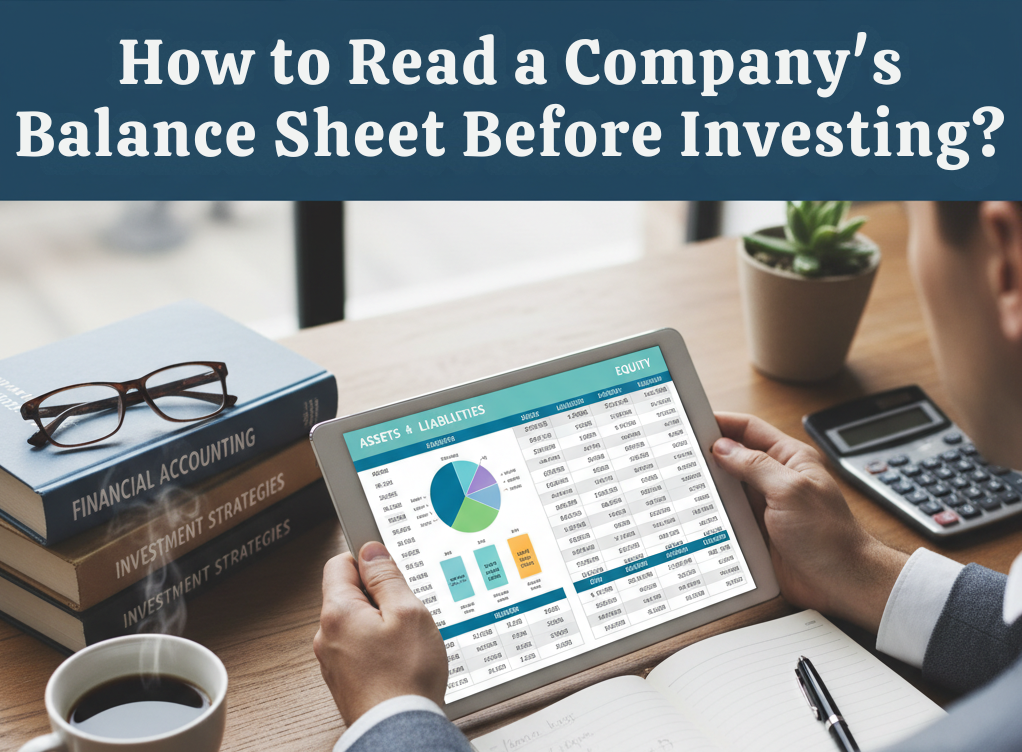
How to Read a Company’s Balance Sheet Before Investing
How to Read a Company’s Balance Sheet Before Investing?
Before investing in any company, one of the most crucial skills every investor should develop is the ability to read and interpret a balance sheet. It’s not just a bunch of numbers—it’s a snapshot of a company’s financial health at a specific point in time. Understanding it can help you judge whether the business is stable, overleveraged, or well-positioned for growth.
Thank you for reading this post, don't forget to subscribe!Let’s break it down step-by-step.
What is a Balance Sheet?
A balance sheet is one of the three main financial statements (along with the income statement and cash flow statement) that companies release every quarter or year. It shows what the company owns (assets), what it owes (liabilities), and what remains for shareholders (equity).
The equation is simple but powerful:
Assets = Liabilities + Shareholders’ Equity
This equation must always balance — hence the name “balance sheet.”
Main Components of a Balance Sheet
1. Assets
Assets represent everything the company owns that has economic value.
a. Current Assets:
These are assets that can be converted into cash within a year. Examples include:
-
Cash and bank balances
-
Accounts receivable (money owed by customers)
-
Inventory
b. Non-Current Assets (Fixed Assets):
These are long-term investments used to run the business:
-
Property, Plant & Equipment (PPE)
-
Investments in subsidiaries or associates
-
Intangible assets (like patents, software, goodwill)
What to check:
A growing asset base, especially in productive assets, indicates business expansion. However, a sudden jump in intangible assets or receivables could be a red flag.
2. Liabilities
Liabilities represent obligations — what the company owes to others.
a. Current Liabilities:
Short-term obligations due within a year, such as:
-
Accounts payable
-
Short-term loans
-
Outstanding expenses
b. Non-Current Liabilities:
Long-term debt obligations such as:
-
Bonds and debentures
-
Bank loans
-
Lease obligations
What to check:
High debt levels can be risky, especially if cash flows are weak. A Debt-to-Equity (D/E) ratio of less than 1 is generally considered healthy for most industries.
3. Shareholders’ Equity
This represents the owners’ claim after all liabilities are paid off. It includes:
-
Share capital
-
Reserves and surplus (retained earnings)
What to check:
Steady growth in equity indicates that the company is retaining profits and strengthening its financial base.
Key Ratios Derived from the Balance Sheet
1. Current Ratio
Current Ratio = Current Assets / Current Liabilities
-
A ratio above 1.5 indicates good liquidity.
-
Too high a ratio could mean idle funds.
2. Debt-to-Equity Ratio
D/E Ratio = Total Debt / Shareholders’ Equity
-
Indicates how much the company relies on borrowed money.
-
A D/E ratio above 2 may suggest high financial risk.
3. Return on Equity (ROE)
ROE = Net Profit / Shareholders’ Equity
-
Reflects how efficiently management uses shareholder funds.
-
A consistently high ROE (>15%) is a sign of strong performance.
How to Analyze a Balance Sheet Like a Pro
1. Look at Trends Over Time
Don’t analyze just one year’s data. Compare at least 3–5 years of balance sheets to spot growth or potential red flags.
2. Check for Leverage
Is the company borrowing heavily to finance growth? If debt is rising faster than revenue, it might be a warning sign.
3. Analyze Working Capital
Working Capital = Current Assets – Current Liabilities
Positive working capital indicates good short-term financial health. Persistent negative working capital could lead to liquidity problems.
4. Understand the Nature of Assets
For manufacturing firms, physical assets like plants and machinery matter.
For IT or service firms, intangible assets (like software, goodwill, or brand value) play a bigger role.
5. Compare with Industry Peers
A strong balance sheet in one industry might be weak in another. Always benchmark against peers.
Illustration: Simplified Balance Sheet Example
| Particulars | FY 2024 (₹ Cr) |
|---|---|
| Assets | |
| Current Assets | 500 |
| Non-Current Assets | 1500 |
| Total Assets | 2000 |
| Liabilities | |
| Current Liabilities | 400 |
| Non-Current Liabilities | 600 |
| Total Liabilities | 1000 |
| Shareholders’ Equity | 1000 |
Here, Assets = Liabilities + Equity (2000 = 1000 + 1000)
The company has a balanced structure with manageable debt (D/E = 0.6).
Key Takeaways for Investors
-
The balance sheet is your window into a company’s financial strength and stability.
-
Look beyond surface numbers—analyze trends, leverage, and asset quality.
-
Use ratios to compare performance across years and peers.
-
Remember, a strong balance sheet doesn’t guarantee success—but it greatly reduces risk.
Related Blogs:
How to Read a Company’s Balance Sheet: Step-by-Step with Examples
How to Use Fundamental Analysis for Indian Stocks
What Is Fundamental Analysis? A Beginner’s Guide
- Disclaimer: This blog post is intended for informational purposes only and should not be considered financial advice. The financial data presented is subject to change over time, and the securities mentioned are examples only and do not constitute investment recommendations. Always conduct thorough research and consult with a qualified financial advisor before making any investment decisions.

